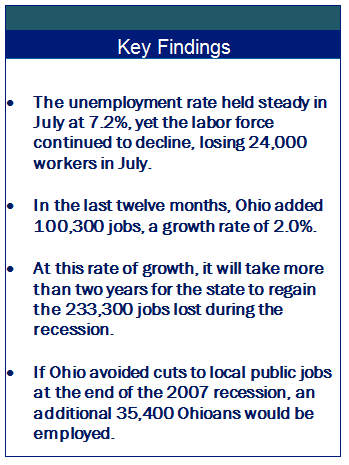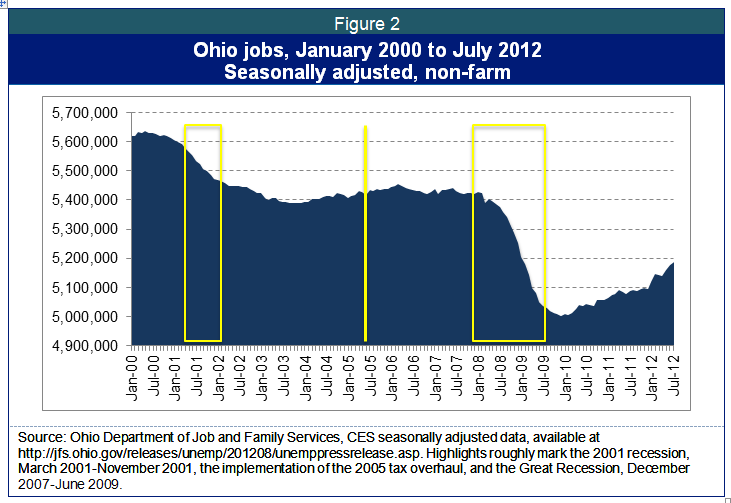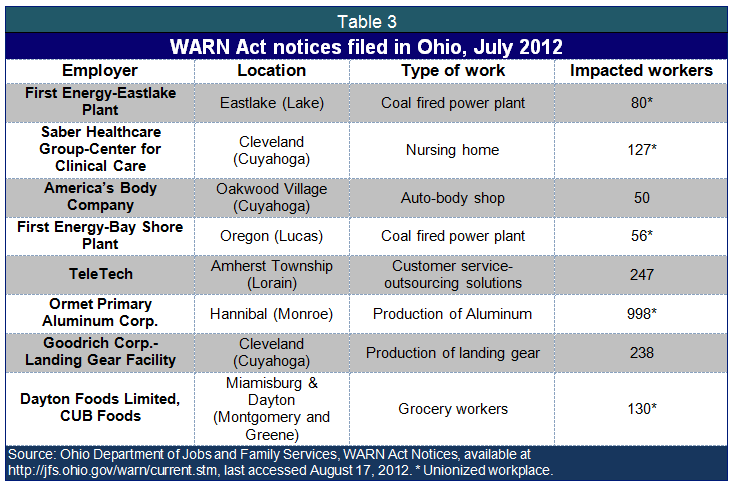
Ohio’s slow climb from recession continued in July
August 17, 2012
Ohio’s slow climb from recession continued in July
August 17, 2012
Press releaseDownload PDF“We have lost 35,400 local public jobs since the end of the last recession, which has been an unnecessary drag on the state’s recovery. As these jobs disappear, vital neighborhood services will also vanish. Ohio needs investment, not austerity, to restore our communities and grow good jobs.” Hannah Halbert, workforce researcher
Data from two separate surveys released by the Ohio Department of Job and Family Services (ODJFS) today suggest that Ohio continues its slow climb back from the recession. The state’s unemployment rate held steady in July at 7.2 percent, according to seasonally adjusted data released from ODJFS’s survey of households for July 2012. 
A separate survey of employers also released today by ODJFS showed that Ohio added 11,000 jobs in July from a month earlier. Month-to-month data is highly subject to revision, and it is ill advised to make too much of month-to-month comparisons.
There is more certainty in examining longer-term job trends. Ohio has now posted five-figure job gains in each of the last three months. Over the last twelve months, the state job total has grown by 100,300 jobs, or 2.0 percent. At that rate of growth it will still take more than two years to generate the additional 233,300 jobs needed to return Ohio to pre-2007 recession levels of employment. That figure would be even higher if population growth were taken into account.
The household survey revealed that the state’s labor force continued to decline, losing 24,000 workers in July. This is a worrying trend and suggests that the recent job gains are not enough to bring discouraged workers back into the workforce.
Figure 2 shows Ohio’s long slog out of the recession. The figure highlights changes in the Ohio job market from key points in time, including the recessions that began in 2001 and 2007, and the 2005 approval of a major state tax overhaul, which promised speedier economic growth. These figures include the latest seasonally adjusted data from the monthly survey of employers (Current Employer Survey) done by ODJFS in co-operation with the U.S. Bureau of Labor Statistics.
Table 1 details these changes. Not only is the state struggling to recover from the 2007 recession, Ohio never recovered from the 2001 recession, having lost more than 404,800 jobs since that recession began. Since the start of the 2007 recession, the state has lost 233,300 jobs. The state job count is also down 4.2 percent since the approval of the 2005 tax overhaul. Manufacturing, which has been one of the primary drivers of Ohio’s recovery, is still down more than 12 percent since the start of the 2007 recession. Even with this summer’s gains, the state is a long way from recovery.
If Ohio had avoided cuts to local public jobs at the end of the 2007 recession, an additional 35,400 Ohioans would be employed. As Figure 3 shows, local public job loss has been a major drag on the state’s recovery. After a brief plateau at the end of 2011 and some small gains in the spring, local public jobs are again declining, dropping more than 1 percent per month in both June and July.
As shown in Table 2, all of Ohio’s public job loss since the official end of the recession in June 2009 has occurred at the local level. As local public jobs disappear, vital neighborhood services also vanish. The 3.7 percent decline in public jobs over the recovery period has been an unnecessary drag on the state’s recovery.
Recent WARN notices in Ohio
The Worker Adjustment Retraining Notification (WARN) Act protects workers and communities by requiring employers with more than 100 employees to provide 60 days’ advance notice of plant closures or mass layoffs. Federal, state, and local government entities are not covered. WARN triggers rapid response services, which can include layoff aversion, training and dislocated worker assistance. As Table 3 shows, eight WARN Act notices were filed with ODJFS in July, impacting 1,926 workers, of whom 1,391 are in a union.
Conclusion
While today’s report is continued good news for the state, one thing is clear: Ohio remains a long way from robust recovery. The decline of local public sector jobs is undercutting our recovery, as these jobs disappear so do vital neighborhood services. We need increased investment, not austerity, to restore our communities and grow good jobs.
JobWatch is an ongoing project of the Economic Policy Institute (http://www.epinet.org) and Policy Matters Ohio, (http://www.policymattersohio.org). Both are nonprofit policy research institutes.
Tags
2012Hannah HalbertJobWatchWork & WagesPhoto Gallery
1 of 22




